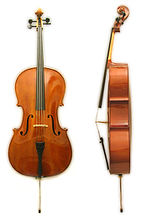Violin family
Class of wooden bowed stringed instruments / From Wikipedia, the free encyclopedia
Dear Wikiwand AI, let's keep it short by simply answering these key questions:
Can you list the top facts and stats about Violin family?
Summarize this article for a 10 year old
The violin family of musical instruments was developed in Italy in the 16th century.[1] At the time the name of this family of instruments was viole da braccio which was used to distinguish them from the viol family (viole da gamba).[2] The standard modern violin family consists of the violin, viola, cello, and (possibly) double bass.[3][4][5]
This article includes a list of general references, but it lacks sufficient corresponding inline citations. (February 2016) |
Instrument names in the violin family are all derived from the root viola, which is a derivative of the Medieval Latin word vitula (meaning "stringed instrument").[6] A violin is a "little viola", a violone is a "big viola" or a bass violin, and a violoncello (often abbreviated cello) is a "small violone" (or literally, a "small big viola"). (The violone is not part of the modern violin family; its place is taken by the modern double bass, an instrument with a mix of violin and viol characteristics.)



